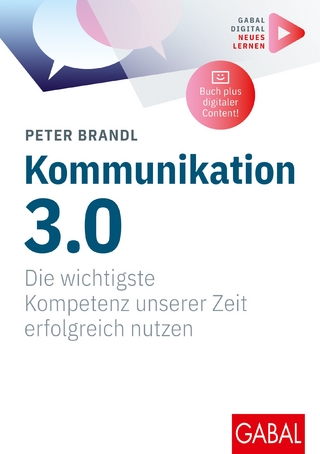
Interpersonal Conflict
McGraw-Hill Education (Verlag)
978-1-260-08354-5 (ISBN)
- Titel ist leider vergriffen;
keine Neuauflage - Artikel merken
Interpersonal Conflict explains the key dynamics of personal conflicts that we all face. Written for courses such as Communication and Conflict, Interpersonal Conflict, Conflict Management, Conflict and Negotiation, and Conflict in Personal Relationships, this textbook examines the central principles of effective conflict management in a wide variety of contexts--whether at home or on the job. Its combination of up-to-date research and examples gives students a theoretical and practical foundation in conflict management.
Instructors and students can now access their course content through the Connect digital learning platform by purchasing either standalone Connect access or a bundle of print and Connect access. McGraw-Hill Connect® is a subscription-based learning service accessible online through your personal computer or tablet. Choose this option if your instructor will require Connect to be used in the course. Your subscription to Connect includes the following:
• SmartBook® - an adaptive digital version of the course textbook that personalizes your reading experience based on how well you are learning the content.
• Access to your instructor’s homework assignments, quizzes, syllabus, notes, reminders, and other important files for the course.
• Progress dashboards that quickly show how you are performing on your assignments and tips for improvement.
• The option to purchase (for a small fee) a print version of the book. This binder-ready, loose-leaf version includes free shipping.
Complete system requirements to use Connect can be found here: http://www.mheducation.com/highered/platforms/connect/training-support-students.html
William Wilmot is Professor of Communication at the University of Montana and is a practicing organizational mediator and conflict manager. Joyce L. Hocker, a practicing family mediator and conflict manager, is a psychotherapist in Missoula, Montana.
PrefaceAcknowledgmentsPart ONE Conflict Components Chapter 1 The Nature of Conflict Interpersonal Conflict Depends on Interpersonal CommunicationFamily Relationships.....Love Relationships..... The Workplace.....The Importance of Skill Development..... Preventing Destructive Conflict.....Conflict Defined.....An Expressed Struggle.....Interdependence..... Perceived Incompatible Goals.....Perceived Scarce Resources..... Interference......Understanding Destructive Conflict......The Four Horsemen......Stressful Drama Examples.....Escalatory Spirals.....Avoidance Spirals......Your Opportunities.....Summary......Key Terms......Review Questions.....Chapter 2 Perspectives on Conflict Your Personal History.....More Reflections on Your Specific HistoryYour Worldview Affects How You Think and Feel About ConflictNegative Views of Conflict.....Positive Views of Conflict..... Insights from Metaphors.....Metaphors Reflecting DangerMetaphors Reflecting OpportunityThe Lens Model of Conflict..... The Dangers of Single Focus.....Identify The Filters on Your Lens.....Gender Filters.....Cultural Filters.....Summary...... Key Terms..... Review Questions.....Chapter 3 Interests and Goals Types of Goals: TRIP.....Topic Goals: What Do We Want?..... Relational Goals: Who Are We to Each Other?.....Identity, or Face-Saving, Goals: Who Am I in This Interaction?.....Process Goals: What Communication Process Will Be Used?.....The Overlapping Nature of TRIP Goals..... Goals Change in Interaction.....Prospective Goals.....Transactive Goals.....Retrospective Goals..... Goal Clarity.....Clarify Your GoalsEstimate the Other’s Goals.....Collaborative Goals.....Summary.....Key Terms..... Review Questions.....Chapter 4 Power: The Structure of Conflict What Is Power?.....Orientations to Power..... Designated Power.....Either/Or Power.....Both/And Power.....Power Denial.....A Relational Theory of Power.....Defining Interpersonal Power.....Individual Power Currencies.....Resources ControlInterpersonal LinkagesCommunication SkillsExpertiseAssessing Your Relational PowerPower Imbalances..... High Power.....Low Power.....Constructive Power Balancing..... Techniques for Balancing Power..... Dialogue.....Restraint.....Focus on InterdependenceThe Power of Calm Persistence.....Stay Actively Engaged..... Empowerment of Low-Power People by High-Power People.....Metacommunication.....What to Say When You Are Low Power.....Summary..... Key Terms.....Review Questions.....Chapter 5 StylesThe Nature of StylesAssessing Your Styles.....Will You Avoid or Engage?.....Avoidance.....Avoidance and Culture..... The Avoid/Criticize Loop.....Avoiding.....Dominating.....Destructive Domination.....Threats.....Compromise.....Competition.....Obliging..... Integrating..... Cautions About Styles.....Verbal Aggressiveness and Verbal AbuseBullying.....Violence..... Patterns of Violence.....Explanations for Violence.....Interaction Dynamics.....Flexibility Creates Constructive Conflict.....Being Stuck..... Are You Stuck?.....Summary.....Key Terms.....Review Questions.....Part TWO InterventionChapter 6 Emotions in ConflictIntroducing Emotion.....Misconceptions of Emotion in Conflict.....Model of EmotionsFinding Feelings.....Functions of Emotions.....Functions of Negative Emotions..... Functions of Positive Emotions.....Core Concerns: Organizing Positive EmotionsThe Mid-Range: The Zone of Effectiveness..... First Steps: Learn to Be a Warrior—of the Heart..... Personal Responsibility for Emotional Transformation.....Summary..... Key Terms.....Review Questions.....Chapter 7 Analyzing Your ConflictsMacro-Level Mapping.....Systems Theory.....Complex Conflict Patterns....Micro-Level Mapping.....Interaction Rules.....Microevents.....Comprehensive Guides..... Conflict Assessment Guide..... Difficult Conversations Guide..... Summary..... Key Terms.....Review Questions.....Chapter 8 Interpersonal NegotiationNegotiation in Everyday Life..... Negotiation Is One Path to Conflict Resolution.....Negotiation and Culture.....Constructive Argumentation: Test Ideas, Not People.....Approaches to Negotiation.....Competitive Negotiation.....Assumptions.....Communication Patterns.....Disadvantages.....Integrative Negotiation..... Assumptions.....Balancing PowerCommunication Patterns.....Coaching for Integrative Negotiators: Putting It Into PracticeNonspecific CompensationDisadvantages of Integrative BargainingSeven Elements of Principled Negotiation...... 1. Attend to the relationship2. Attend to all elements of communication3. Focus on interests, not positions4. Generate many options5. Find legitimate criteria6. Analyze the “best alternative to a negotiated agreement (BATNA7. Work with fair and realistic commitmentsWhat makes implementing the Core Concerns So Difficult?The Language of Integration..... Competitive and Integrative Phases......Summary.....Key Terms.....Review Questions.....Chapter 9 Third-Party InterventionThe Need for Third Parties.....Advantages of Using Skilled Third Parties.....Informal Help.....Conditions for Helping..... Cautions about Informal Intervention.....Formal Intervention.....The Intervention Continuum..... When the Parties Decide.....When an Outsider Decides.....Arbitration: An Expert DecidesSumma
ry.....Key Terms....Review Questions.....Chapter 10 The Practice of Forgiveness and Reconciliation by Gary W. Hawk, University of MontanaForgiveness and Reconciliation in the Context of Interpersonal Conflict Some Definitions..... What’s to Forgive?.....Some Misconceptions about Forgiveness.....When There Is an Imbalance of Power..... The Matter of Memory..... Decision or Process?.....Emphasizing Process over Decision.....Getting Stuck: Eddies in the River.....The Personal and Interpersonal Dimensions of Forgiveness.....Gestures.....The Value and Limits of Apology.....Switching the Point of View: Receiving Forgiveness and Forgiving Oneself Reconciliation: A Late Stage in the Journey.....Insights from History, Politics, and Literature.....The Strand of Truth.....The Strand of Forbearance.....The Strand of Empathy.....Commitment to the Relationship out of Awareness of Our InterdependenceThe Tie that Binds: A Multicultural Example from HawaiiConclusion.....Summary.....Key Terms.....Review Questions.....ReferencesName IndexSubject Index
| Erscheinungsdatum | 18.05.2017 |
|---|---|
| Verlagsort | OH |
| Sprache | englisch |
| Maße | 185 x 229 mm |
| Gewicht | 603 g |
| Themenwelt | Sachbuch/Ratgeber ► Beruf / Finanzen / Recht / Wirtschaft ► Briefe / Präsentation / Rhetorik |
| Geisteswissenschaften ► Sprach- / Literaturwissenschaft ► Sprachwissenschaft | |
| ISBN-10 | 1-260-08354-3 / 1260083543 |
| ISBN-13 | 978-1-260-08354-5 / 9781260083545 |
| Zustand | Neuware |
| Haben Sie eine Frage zum Produkt? |
aus dem Bereich


